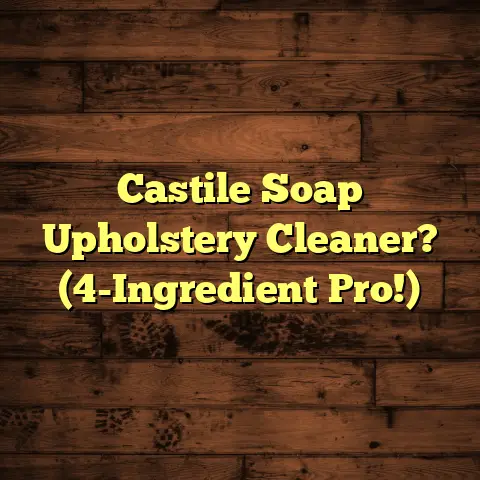How To Wash Tiles With Acid?
And believe me, sometimes, a simple
mop and bucket just don’t cut it.
That’s
when the big guns come out: acid.
But
before you reach for that bottle of
mystery cleaner, let’s talk craftsmanship.
Craftsmanship in floor care isn’t just
about slapping down some tiles; it’s about
understanding the materials, knowing how
they react, and treating them with the
respect they deserve.
It’s about preserving
the beauty and integrity of your investment,
striking that perfect balance between
cleanliness and care.
Think of it like this: you wouldn’t use
the same brush to paint a delicate
watercolor as you would to slap paint on a
barn, right?
Same goes for tiles!
In this guide, I’m going to walk you
through the ins and outs of washing tiles
with acid.
We’ll cover everything from
understanding different tile types to
safety precautions, step-by-step
instructions, and even troubleshooting
common issues.
Trust me, I’ve made my fair share of mistakes along the way, so I’m here to help you avoid them!
Section 1: Understanding Tile Materials
Okay, let’s dive into the nitty-gritty:
tile types.
Not all tiles are created
equal, and knowing the difference is crucial
when deciding whether or not to use acid.
Ceramic Tiles: These are your everyday workhorses – affordable, durable, and come in a huge range of styles. They’re typically glazed, which makes them water-resistant and relatively easy to clean.
Porcelain Tiles: Think of porcelain as ceramic’s tougher, more refined cousin. They’re fired at higher temperatures, making them denser, less porous, and more resistant to water and stains. Porcelain is a great choice for high-traffic areas and outdoor spaces.
Natural Stone Tiles: This category includes materials like granite, marble, limestone, and slate. Each stone has its own unique characteristics, but they all share one thing in common: they’re porous and can be easily damaged by harsh chemicals.
Glass Tiles: These can add a touch of elegance and sparkle to any space. They’re non-porous and stain-resistant, but they can be prone to scratching.
So, why does this matter when it comes to
acid cleaning?
Well, different tiles react
differently to acidic cleaners.
For example, natural stone tiles like
marble and limestone are highly sensitive to
acid.
The acid can actually etch the
surface, leaving behind dull spots and
irreversible damage.
I learned this the hard
way on a job years ago – let’s just say
the client wasn’t thrilled!
Porcelain and ceramic tiles are generally
more resistant to acid, but it’s still
important to proceed with caution.
The
glaze on ceramic tiles can be damaged by
strong acids, leading to discoloration or a
loss of shine.
Always, and I mean always, check the
manufacturer’s recommendations before using
any type of cleaner on your tiles.
If you’re
not sure what type of tile you have, it’s
best to err on the side of caution and test
the cleaner in an inconspicuous area first.
Section 2: The Role of Acid in Tile Cleaning
Alright, now that we’ve covered the different types of tiles, let’s talk about the magic (and potential danger) of acid cleaning.
But first, a little chemistry lesson: Acid
cleaners work by dissolving mineral deposits,
hard water stains, and other stubborn grime
that regular cleaners can’t touch.
They do
this by breaking down the chemical bonds
that hold these deposits together.
Think of it like this: those stubborn
stains are like tiny fortresses built on
your tiles.
Acid is like a siege weapon,
breaking down the walls and allowing you to
finally conquer the grime!
Here are some common acidic cleaners you might encounter:
Hydrochloric Acid (Muriatic Acid): This is a strong acid that’s often used for heavy-duty cleaning, such as removing efflorescence (that white, powdery substance that sometimes appears on tiles). It’s highly corrosive and should be handled with extreme care.
Phosphoric Acid: This is a milder acid that’s often found in toilet bowl cleaners and rust removers. It’s effective at removing mineral deposits and hard water stains.
Citric Acid: This is a natural acid that’s found in citrus fruits like lemons and limes. It’s a gentler option than hydrochloric or phosphoric acid, but it can still be effective at removing mild stains and grime.
So, what are the benefits of using acid
for cleaning tiles?
Well, when used
correctly, acid can:
Remove tough stains: Acid can dissolve stains that other cleaners simply can’t touch, such as rust stains, hard water stains, and mineral deposits.
Restore shine: Acid can remove dulling buildup, revealing the original shine of your tiles.
Deep clean grout: Grout is porous and can easily trap dirt and grime. Acid can penetrate the grout lines and dissolve stubborn buildup.
But here’s the catch: acid can also damage
your tiles if you’re not careful.
It can
etch sensitive surfaces, discolor the glaze,
and even weaken the structural integrity of
the tile.
According to the Tile Council of North
America (TCNA), using the wrong cleaning
products is one of the most common causes of
tile damage.
So, it’s crucial to choose the
right acid for the job and to use it
correctly.
Section 3: Safety Precautions
Okay, folks, this is where things get
serious.
Working with acid is no joke, and
it’s essential to take the necessary safety
precautions to protect yourself and your
home.
First and foremost, always wear
personal protective equipment (PPE) when
working with acid.
This includes:
Gloves: Choose acid-resistant gloves that extend past your wrists. Nitrile gloves are a good option.
Goggles: Protect your eyes from splashes and fumes. Make sure your goggles fit snugly and provide a good seal around your eyes.
Respirator: Acid fumes can be irritating and even dangerous to inhale. Wear a respirator that’s specifically designed to filter out acid fumes.
Protective Clothing: Wear long sleeves and pants to protect your skin from splashes. Consider wearing an apron or other protective garment.
In addition to PPE, it’s also important
to ensure adequate ventilation.
Open
windows and doors to allow fresh air to
circulate.
If you’re working in a confined
space, consider using a fan to improve
ventilation.
Always read the product label carefully before using any acidic cleaner. The label will provide important information about the chemical’s hazards, precautions, and first aid measures.
Never mix acid with other chemicals, especially bleach. Mixing acid and bleach can create chlorine gas, which is highly toxic and can be fatal.
Always add acid to water, never water to acid. Adding water to acid can cause a violent reaction that can splash acid onto your skin or clothing.
Keep children and pets away from the work area. Acid can be harmful if swallowed or inhaled, and it can also irritate the skin and eyes.
Have a plan in case of an accident.
Know where the nearest source of water is in
case you need to flush acid off your skin or
eyes.
Keep a bottle of baking soda on hand to
neutralize acid spills.
Here’s a little story to illustrate why
safety is so important: I once worked on a
job where a coworker didn’t wear gloves when
using muriatic acid.
He ended up with a
nasty chemical burn on his hands that took
weeks to heal.
It was a painful reminder
that even a small amount of acid can cause
serious damage.
Section 4: Preparing for Tile Cleaning
Alright, you’ve got your safety gear,
you’ve read the labels, and you’re ready to
tackle those grimy tiles.
But before you
start slinging acid, let’s make sure you’re
properly prepared.
Here’s a checklist of materials you’ll need:
Acid Cleaner: Choose the right acid for the job, based on the type of tile you have and the severity of the staining.
Bucket: Use a plastic bucket that’s specifically designed for cleaning chemicals.
Mop or Sponge: Choose a mop or sponge that’s made of acid-resistant material. Avoid using natural sponges, as they can be damaged by acid.
Scrub Brush: A stiff-bristled scrub brush is essential for removing stubborn stains and grime.
Water: You’ll need plenty of clean water for diluting the acid and rinsing the tiles.
Neutralizing Agent: Baking soda is a great option for neutralizing acid spills.
pH Test Strips: These can help you ensure that the acid has been properly neutralized after cleaning.
Once you’ve gathered your materials, it’s time to prepare the area.
Clear the area: Remove any furniture, rugs, or other items from the area you’ll be cleaning.
Sweep or vacuum: Remove any loose dirt, dust, or debris from the tiles.
Test in an inconspicuous area: Before
you start cleaning the entire floor, test the
acid in a small, inconspicuous area to check
for compatibility.
Apply a small amount of
the diluted acid to the area and let it sit
for the recommended amount of time.
Then,
rinse the area thoroughly and check for any
signs of damage or discoloration.
Testing is key.
I remember one time I was
cleaning a bathroom floor and didn’t test
the acid first.
Turns out, the tiles were
made of a sensitive type of limestone, and
the acid etched the surface, leaving behind
a dull, uneven finish.
It was a costly
mistake that could have been avoided with a
simple test.
Section 5: Step-by-Step Guide to Washing Tiles with Acid
Alright, deep breath.
You’ve prepped,
you’re protected, and you’re ready to
restore those tiles to their former glory.
Let’s get to it!
Step 1: Dilution of the Acid
This is arguably the most important step.
Always dilute the acid according to the manufacturer’s instructions. Using too much acid can damage your tiles, while using too little may not be effective.
The dilution ratio will vary depending on
the type of acid you’re using and the
severity of the staining.
For example,
muriatic acid is typically diluted at a
ratio of 1 part acid to 10 parts water, while
citric acid may be used at a higher
concentration.
Always add the acid to the water, never the other way around. Pour the water into the bucket first, then slowly add the acid, stirring gently as you go.
Step 2: Application of the Acid
There are several methods you can use to apply the acid solution to the tiles:
Mop: A mop is a good option for cleaning large areas. Dip the mop into the acid solution and wring out the excess. Apply the solution to the tiles in a smooth, even layer.
Sponge: A sponge is a good option for cleaning small areas or for spot-treating stains. Dip the sponge into the acid solution and wring out the excess. Apply the solution to the tiles, focusing on the stained areas.
Sprayer: A sprayer can be used to apply the acid solution to grout lines or other hard-to-reach areas. Be sure to use a sprayer that’s specifically designed for use with chemicals.
Step 3: Letting the Solution Sit
Once you’ve applied the acid solution to
the tiles, let it sit for the recommended
amount of time.
This will allow the acid to
penetrate the stains and loosen the buildup.
The amount of time you should let the
solution sit will vary depending on the type
of acid you’re using and the severity of the
staining.
For example, muriatic acid may only
need to sit for a few minutes, while citric
acid may need to sit for up to an hour.
Never let the acid solution dry on the tiles. If the solution starts to dry, reapply it or rinse the tiles immediately.
Step 4: Scrubbing
After letting the acid solution sit, it’s
time to scrub the tiles.
Use a stiff-bristled
scrub brush to loosen any remaining stains
and buildup.
Scrub in a circular motion, applying
moderate pressure.
Pay special attention to
grout lines, as they tend to trap dirt and
grime.
Step 5: Rinsing
Once you’ve scrubbed the tiles, it’s
essential to rinse them thoroughly to
neutralize the acid.
Use plenty of clean
water to remove any remaining acid solution.
Rinse the tiles several times, until the
water runs clear.
You can use a mop, sponge,
or hose to rinse the tiles.
To ensure that the acid has been completely neutralized, you can test the pH of the rinse water using pH test strips. The pH should be neutral (around 7).
If the pH is still acidic (below 7), continue rinsing the tiles until the pH is neutral.
You can also use a neutralizing agent, such
as baking soda, to help neutralize the acid.
Sprinkle baking soda over the tiles and let
it sit for a few minutes, then rinse the
tiles again.
Step 6: Drying
After rinsing the tiles, dry them
thoroughly to prevent streaks and water
spots.
You can use a clean towel, mop, or
squeegee to dry the tiles.
If you’re using a towel, be sure to use a clean, dry towel to avoid spreading dirt and grime.
If you’re using a mop, wring it out thoroughly before drying the tiles.
If you’re using a squeegee, overlap each stroke slightly to ensure that all of the water is removed.
Section 6: Addressing Common Tile Cleaning Issues
Even with the best preparation and
technique, things can sometimes go wrong.
Here are some common issues you might
encounter when cleaning tiles with acid, and
how to address them:
Etching: This is a common problem when cleaning sensitive tiles, such as marble or limestone. Etching occurs when the acid dissolves the surface of the tile, leaving behind a dull, uneven finish.
- Solution: If you notice etching, stop cleaning immediately and rinse the tiles thoroughly. You may be able to buff out minor etching with a polishing compound, but severe etching may require professional restoration.
- Solution: If you notice etching, stop cleaning immediately and rinse the tiles thoroughly. You may be able to buff out minor etching with a polishing compound, but severe etching may require professional restoration.
Discoloration: Acid can sometimes discolor the glaze on ceramic tiles, especially if the glaze is old or damaged.
- Solution: If you notice discoloration, stop cleaning immediately and rinse the tiles thoroughly. Unfortunately, there’s not much you can do to reverse discoloration. You may need to replace the affected tiles.
- Solution: If you notice discoloration, stop cleaning immediately and rinse the tiles thoroughly. Unfortunately, there’s not much you can do to reverse discoloration. You may need to replace the affected tiles.
Grout Damage: Acid can damage grout, especially if the grout is old or cracked.
- Solution: If you notice grout damage, stop cleaning immediately and rinse the tiles thoroughly. You may need to repair or replace the damaged grout.
- Solution: If you notice grout damage, stop cleaning immediately and rinse the tiles thoroughly. You may need to repair or replace the damaged grout.
Lingering Acid Smell: Even after rinsing the tiles thoroughly, you may still notice a lingering acid smell.
- Solution: To remove the acid smell, ventilate the area thoroughly. You can also try using an odor eliminator or baking soda to absorb the smell.
- Solution: To remove the acid smell, ventilate the area thoroughly. You can also try using an odor eliminator or baking soda to absorb the smell.
The key takeaway here is to know your tile.
If you’re unsure about the type of tile you have or how it will react to acid, it’s always best to consult with a professional.
Section 7: Maintenance Tips for Tile Care
Okay, you’ve successfully washed your
tiles with acid and they’re looking
fantastic.
But the job’s not over yet!
To
keep your tiles looking their best, it’s
important to follow a regular maintenance
routine.
Here are some tips for tile care:
Sweep or vacuum regularly: This will remove loose dirt and debris that can scratch or dull the surface of your tiles.
Mop with a pH-balanced cleaner: Avoid using harsh chemicals or abrasive cleaners, as they can damage the tiles. Choose a pH-balanced cleaner that’s specifically designed for tile.
Clean spills immediately: Spills can stain or damage tiles if they’re left untreated. Clean up spills as soon as possible with a clean, damp cloth.
Seal grout: Grout is porous and can easily trap dirt and grime. Seal your grout regularly to protect it from stains and make it easier to clean.
Use mats and rugs: Place mats and rugs in high-traffic areas to protect your tiles from wear and tear.
Avoid using abrasive cleaners or tools: Abrasive cleaners and tools can scratch or damage the surface of your tiles.
Consider professional cleaning: Even with regular maintenance, your tiles may eventually need a professional cleaning. Consider hiring a professional tile cleaner every year or two to keep your tiles looking their best.
Conclusion
So, there you have it: a comprehensive
guide to washing tiles with acid.
I know it
can seem daunting, but with the right
knowledge, preparation, and safety
precautions, you can achieve beautifully
restored surfaces.
Remember, craftsmanship in tile cleaning isn’t just about following instructions; it’s about understanding the materials, respecting their properties, and taking the time to do the job right.
And if you’re ever in doubt, don’t hesitate
to call in a professional.
Sometimes, it’s
better to leave it to the experts than to
risk damaging your tiles.
Happy cleaning, folks! And remember, stay safe and always wear your PPE.





